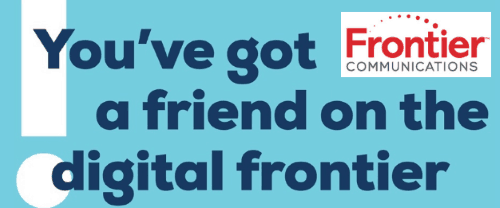
With friends like these…
In an effort to attract new business, Frontier Communications has launched a new nationwide brand platform it claims will help customers “facing challenges and frustrations navigating today’s internet services market.”
The “Don’t Go it Alone” campaign advertises Frontier as your friend on the digital frontier.
In one ad, a balladeer laments customers trying to use a home internet connection that is too slow and unreliable to depend on for working from home. The ad shows customers flocking to nearby coffee shops “looking for bandwidth” they do not have at home.
While the ads claim Frontier’s FiOS network is faster than its competitor — Charter Spectrum, many Frontier customers living outside of a FiOS service area will likely find Frontier’s ads ironic. That is because Frontier has a poor track record achieving the promised speeds it advertises to its large base of DSL customers. The 2016 FCC Report, “Measuring Fixed Broadband” (the annual reports were discontinued by the Trump Administration’s FCC in early 2017), found Frontier a poor performer. Even its fiber network Frontier FiOS was measured losing ground in delivering advertised speeds and performance.
Minnesota Public Radio reports hundreds of complaints about Frontier Communications have prompted statewide public hearings about the company’s alleged poor performance. MPR shares the stories of two frustrated Frontier DSL customers paying for service they do not get. (3:28)
 “Our internet here is horrible, our provider is Frontier,” Monica King Von Holtum of Worthington in southwest Minnesota, told Minnesota Public Radio. “It’s infuriating.”
“Our internet here is horrible, our provider is Frontier,” Monica King Von Holtum of Worthington in southwest Minnesota, told Minnesota Public Radio. “It’s infuriating.”
Her service is so bad, she can tell if a neighbor starts using the internet or another family member starts browsing.
“If I’m literally the only person using the internet, it’s fine,” said King Von Holtum. “As soon as we have one or more people using different devices it just tanks and we can’t get anything done.”
She is hardly alone. In Minnesota, the Public Utility Commission has received more than 400 complaints and comments about Frontier’s frustrating performance. Customers report service interruptions lasting up to a week and internet speeds slower than dial-up.
One customer said Frontier lacks “common decency” because of the way it treats its customers, often stuck with only one choice for internet access in their rural service areas.
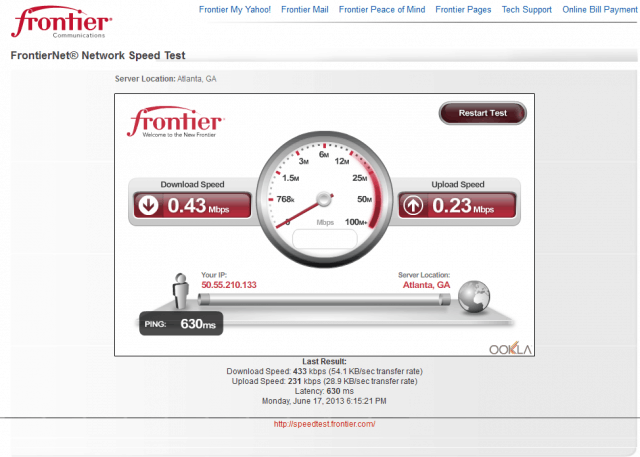
A speed test showing 0.4 Mbps from 2013 shows this is an ongoing problem.
King Von Houltum showed MPR the results of a speed test while being interviewed.
“We have 0.4 megabits per second,” said King Von Holtum, who pays Frontier for 6 Mbps service. “And our upload is pretty much nonexistent.”
Melody Webster’s family makes regular 5-mile trips into the town of Cannon Falls to use their local library’s Wi-Fi service. It is the only way her children can complete their school assignments, because Frontier’s DSL struggles to open web pages. Webster has called Frontier again and again about the speed problems, but told the public radio station she gets “lied to or pretty much laughed at.”
That’s a story Frontier’s balladeer is not likely to put to song.
Frontier spent an undisclosed amount hiring the ad agency responsible for the new advertising.
“A brand campaign must be creative and memorable. It also has to drive a client’s business forward,” said Lance Jensen, chief creative officer of Hill Holliday, which created the campaign. “The Balladeer is a fun and accessible character who brings humanity and humor to the frustrating experience of dealing with internet and TV service. We can’t wait to put him to work for the Frontier brand.”
The campaign launches this week in Frontier markets nationally and includes broadcast, radio, online video, out of home, digital and social components.
An “affable balladeer” sings about the frustrations of internet users who do not get the internet service they paid for, in this new 30-second ad from Frontier Communications. Ironically, slow speed is the most common complaint about Frontier’s own DSL service. (0:30)


 Subscribe
Subscribe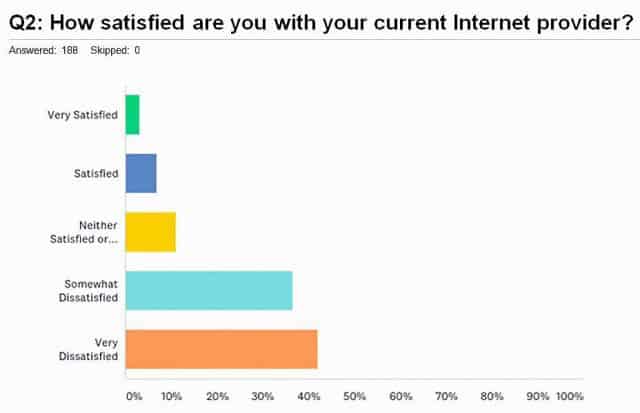
 Frontier representatives responded to the survey results at a March 27 Elko City Council meeting.
Frontier representatives responded to the survey results at a March 27 Elko City Council meeting.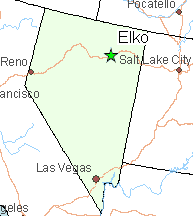 Frontier also noted internet traffic was up 25% in the Elko area, primarily as a result of video streaming, social media, and cloud services.
Frontier also noted internet traffic was up 25% in the Elko area, primarily as a result of video streaming, social media, and cloud services.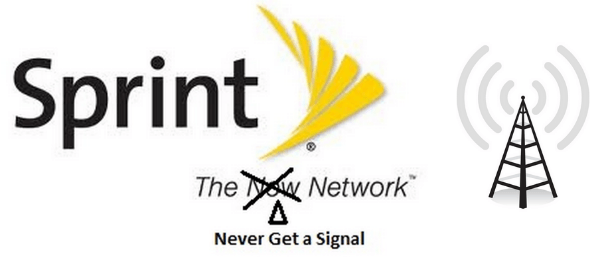 Sprint customers will once again have to endure service interruptions and disruptions and the possibility of degraded service after the cellular company quietly announced it was terminating leases with Crown Castle and American Tower — two of the largest owners of shared communications towers in the country, and relocating Sprint cell sites to government-owned property.
Sprint customers will once again have to endure service interruptions and disruptions and the possibility of degraded service after the cellular company quietly announced it was terminating leases with Crown Castle and American Tower — two of the largest owners of shared communications towers in the country, and relocating Sprint cell sites to government-owned property.
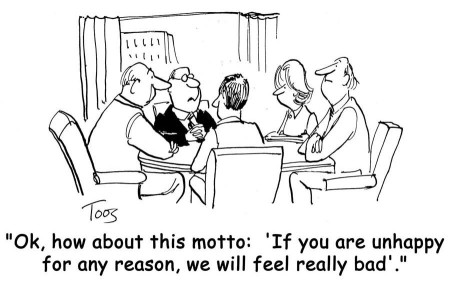 Yes, Comcast is fired. We took a page from young adults’ playbook and canceled the phone. It seems nobody younger than 40 these days owns a land line, why should we? Even our smart friend Barbara said the only reason she hangs onto the land line is so she can use it to locate her misplaced cell phone.
Yes, Comcast is fired. We took a page from young adults’ playbook and canceled the phone. It seems nobody younger than 40 these days owns a land line, why should we? Even our smart friend Barbara said the only reason she hangs onto the land line is so she can use it to locate her misplaced cell phone. While AT&T trumpets vague plans to upgrade up to 100 cities with gigabit fiber to the home service, some AT&T GigaPower U-verse customers in Austin wish they could just consistently get the 300Mbps service they were promised.
While AT&T trumpets vague plans to upgrade up to 100 cities with gigabit fiber to the home service, some AT&T GigaPower U-verse customers in Austin wish they could just consistently get the 300Mbps service they were promised. “I upgraded to GigaPower last December and since then, the service started getting disconnected multiple times per week,” wrote ybasha. “Sometimes it lasts a few minutes and sometimes longer. When that happens, I lose Internet and TV service. I called technical support multiple times. They sent technicians twice. One of them swapped the modem, but I still have the problem.”
“I upgraded to GigaPower last December and since then, the service started getting disconnected multiple times per week,” wrote ybasha. “Sometimes it lasts a few minutes and sometimes longer. When that happens, I lose Internet and TV service. I called technical support multiple times. They sent technicians twice. One of them swapped the modem, but I still have the problem.” AT&T GigaPower is supposed to offer 300/300Mbps service today with an upgrade to gigabit Internet forthcoming later this year. But not every customer comes close to getting those speeds.
AT&T GigaPower is supposed to offer 300/300Mbps service today with an upgrade to gigabit Internet forthcoming later this year. But not every customer comes close to getting those speeds. 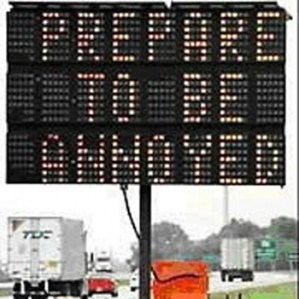 Kim R. in Cedar Falls, Tex. isn’t happy either:
Kim R. in Cedar Falls, Tex. isn’t happy either: